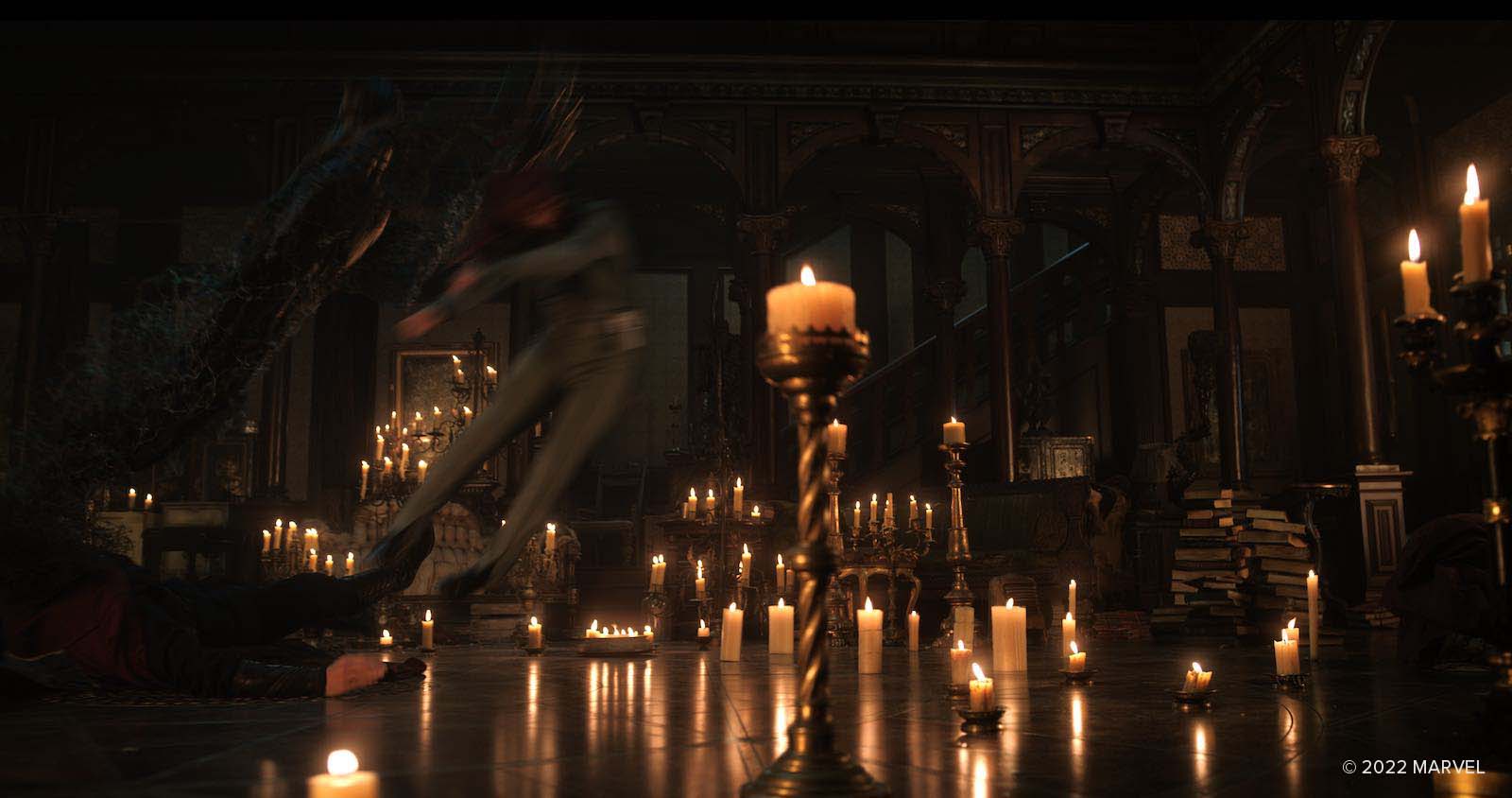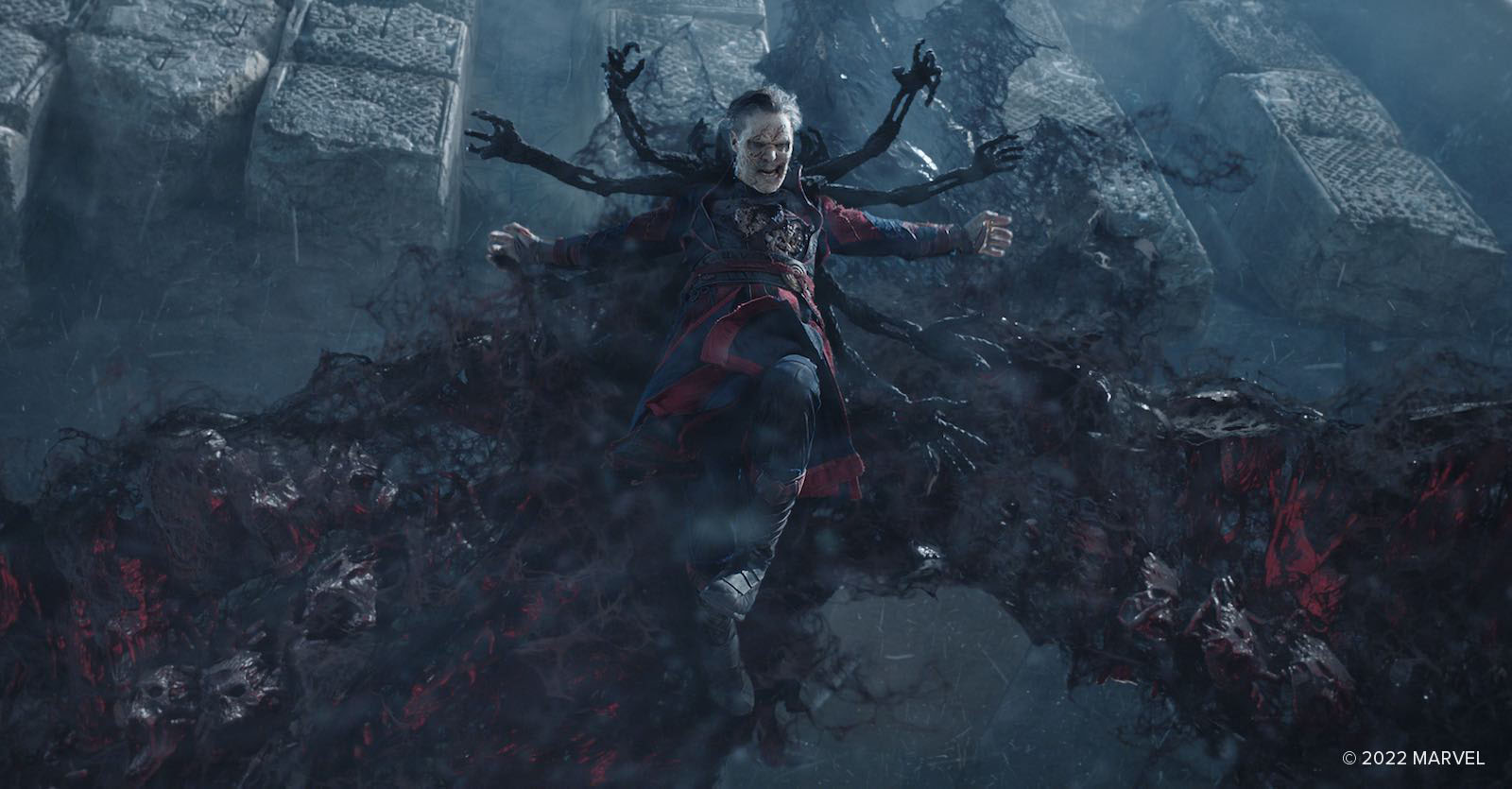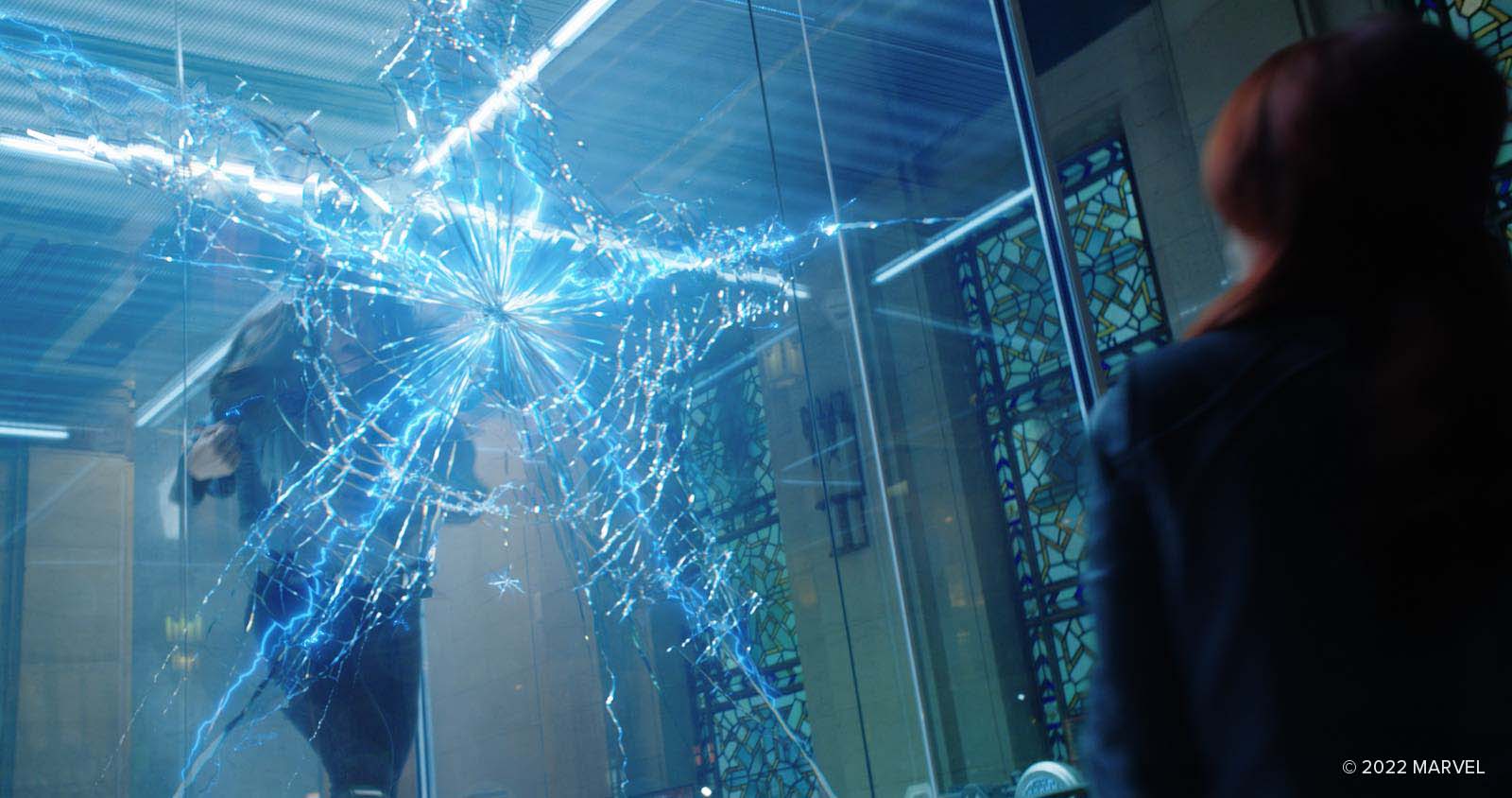Doctor Strange in the Multiverse of Madness with ftrack Studio
Trixter delivers 80 shots on Doctor Strange in the Multiverse of Madness with ftrack Studio
Doctor Strange in the Multiverse of Madness takes the MCU into weird and wonderful new places.
The second solo outing for Marvel’s Master of the Mystic Arts sees Stephen Strange team up with America Chavez, a supernatural being able to travel the multiverse, with whom he navigates multiversal realities and battles the new threat of a bereaved and desperate Scarlet Witch.
Sam Raimi, who previously created three Spider-Man films for Sony, took the helm for Doctor Strange 2, and his dark and energetic approach to direction is evident across the film’s runtime. Visual Effects Supervisor Janek Sirrs (Spider-Man: From From Home, Avengers Assemble) joined Raimi in this endeavor, and together the two created a visual spectacle featuring an enormous, tentacled interdimensional being, a zombified version of Doctor Strange, a geometric, kaleidoscopic universe where terms like “up” and “down” have little meaning, and so much more.
Providing support across the production was Trixter. The VFX studio is no stranger to the MCU, with work on Loki, Thor, Shang-Chi, Ms. Marvel, Spider-Man, Avengers, and so much more. For Doctor Strange 2, the team’s Munich and Berlin facilities were charged with creating 80 shots over four months.
“Marvel wanted to involve us on Doctor Strange 2, so we rescheduled our deliveries on their other shows and freed up the necessary capacity,” explains Alessandro Cioffi, Trixter VFX Supervisor. “Working with Janek was great, as he is so experienced in the practical work and knows how to manage demanding and complex shows in such a short time. He asked us what we at Trixter could reasonably deliver in those four months, we worked it out, and we were in!”
The magic of ftrack
Four months and 80 shots on a production as visually complex as Doctor Strange 2 is no mean feat. Thankfully, Trixter had a trick card up its sleeve in the form of ftrack Studio – the production tracking and media review platform that forms a major component of Trixter’s pipeline and workflow.
“ftrack is the heart of production at Trixter. We use it for media review, project management, and scheduling,” says Giacomo Trevisiol, VFX Producer at Trixter. “I use ftrack as a daily digest. So when I start my day, I can see what was published overnight; I know exactly what‘s been delivered, what’s still pending, and the status of all tasks. All that information is ready and waiting.”
For example, ftrack Studio proved particularly useful on 50 of the 80 shots under Trixter’s supervision, devoted to Doctor Strange’s attempt to dreamwalk into the corpse of his alternate version. In the scene, damned spirits from Mount Wundagore emerge from Doctor Strange’s body, and it’s up to Christine Palmer (Rachel McAdams) to use the Brazier of Bom’Galiath against the demonic entities.

“The physical set for this scene was constructed up to the columns in the background; we constructed digital ceilings from that point on and also recreated a special candlelight using CG candlelight sources,” says Cioffi. “At the centre of the scene lies an unconscious Doctor Strange, whose body was hectically moved around with a wired stand-in to give it convincing weight and human behaviour.”
The Mount Wundagore Spirits emanate from Doctor Strange’s eyes in clouds of dark smoke. “We created a dilated pupil and squeezed the iris, so there wasn’t much trouble matchmoving the eyeball and creating a dome where the demons could float inside,” says Cioffi. “When the spirits emerge, their bodies were animated and the tails made of dark smoke and cloth. We ensured the animation interacted well with the environment, props, and corpse.”

When Christine uses the Brazier of Bom’Galiath, it erupts with a massive ball of incandescent fire. “The on-set prop had a white LED,” explains Cioffi. “We turned that light into a fiery, amber light, then enhanced the mouth of the Brazier for lighting interaction.”
I use ftrack as a daily digest. When I start my day, I know exactly what‘s been delivered, what’s still pending, and the status of all tasks.
Bringing the dead to life
Doctor Strange’s attempt to dreamwalk is successful, resulting in one of the most Sam Raimi touches witnessed throughout the film’s runtime: the Deadite-like reanimated corpse of Strange’s alternate self.
Toward the end of the film’s production, some of Zombie Strange’s appearance required reconceptualization – it was up to Trixter to help.
“We needed to dial in the right amount of ‘zombieness’ and achieve a suitable level of death decay for a specific moment in the movie,” explains Cioffi. “The team created and mixed in several wounds and decaying features. Ultimately they created a blend of the healthy and zombie versions of Doctor Strange that was consistent with the character’s appearance throughout the rest of the movie.”

ftrack Studio certainly helped as the Trixter team back-and-forthed on the right look. “For me, in my role as a supervisor, ftrack is an invaluable help in my daily routine and reviews,” says Cioffi. “I can create playlists directly linked to our review tool, RV, and by using these playlists, we can open all of the shots per department and begin our reviews. During reviews on scenes like those with Zombie Strange, every note that we write on RV is published instantly into ftrack Studio, so it’s on record with the associated screenshots, annotations, and everything else relevant for the artist to continue their work. Such a workflow was crucial, and it certainly helped us face the challenge of the pandemic and remote work. With ftrack Studio, everyone stayed in the loop.”
Cloaks and portals
Trixter worked on numerous other shots in Strange’s multiversal adventure, including several featuring the character’s anthropomorphized Cloak of Levitation.
“The Cloak of Levitation comes with a great character animation and simulation history, so there was nothing new we had to recreate from scratch. However, we did need to understand and use the same creative language as that seen in the Cloak’s previous MCU appearances,” says Trevisiol. “We received some specific descriptions from Sam Raimi on how the cape should behave. For example, in one scene, the cape needed to act with the excitement of a dog that has just seen its owner for the first time in a long time!
“The challenge with the Cloak was that we needed to balance believability with magic,” he continues. “The audience had to simultaneously believe what they saw was a heavy piece of physical cloth with various coefficients of flexibility and weight, and also a character with intention and agency. The team did a fantastic job in achieving that.”

Trixter also had a hand in creating the star-shaped dimensional portals that appear when America Chavez employs her universe-hopping powers. “The look of the effect was driven by the comic books – we worked to give the portals a photorealistic feel, with cracks of electricity imbuing the effect with a sense of physicality,” says Trevisiol.
The work that Trixter took on for Doctor Strange and the Multiverse of Madness was certainly varied, and the short timeline for delivery pushed the team to work fast. “The schedule was short, and with the film’s release date locked in, there was no chance of any extension,” says Trevisiol. “Nevertheless, Trixter delivered on time. Praise goes to the phenomenal artists at Trixter for achieving such stunning results – and thanks to ftrack Studio for keeping us aligned as we worked toward that deadline.”
Source:Ftrack

熱門頭條新聞
- Nordic Game 2025: Good Things Ahead
- Battery Note+UNDERGROUNDED will release in 2025!
- Sugardew Island – Your Cozy Farm Shop Launches for PC and Consoles in March 2025!
- Multiplayer game Don’t Kill Rumble debuts with thrilling king of the hill action gameplay at The Latin American Games Showcase
- Submissions for MIAF 2025 are now OPEN.
- Announcing ! From the creators of Core Keeper
- Mobile Legends:M7 World Championship set for January 2026
- Submission deadline extended!
